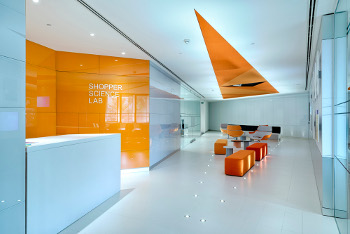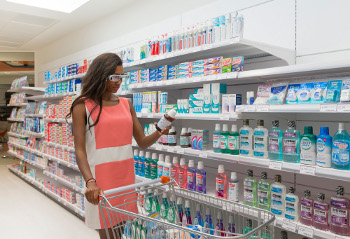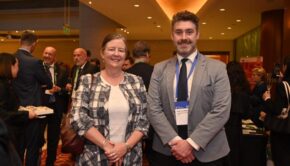Inside the mind of the shopper

Understanding how shoppers’ decision-making processes work is a fascinating subject which retailers and brands have spent millions on in a bid to further their understanding of what makes consumers’ minds tick. Gillian Hamill travelled to Brentford in West London to see how GSK Consumer Healthcare’s new Shopper Science Lab is making strides in this area
15 November 2013
It’s not every day you’re given the opportunity to make your own toothpaste, but this is just one of the out-of-the-ordinary experiences ShelfLife encountered at the press launch of a new state-of-the-art research facility. The new Shopper Science Lab by GlaxoSmithKline (GSK) Consumer Healthcare, launched on 10 October, aims to provide an in-depth understanding of how and why shoppers make decisions and what influences their choices.
Groundbreaking technology
With 10,000 sq ft filled with groundbreaking technology, the Shopper Science Lab is actually the biggest facility of its kind in Europe. It is home to the world’s largest seamless touch-screen (virtual insight and engagement wall) at 5.32m wide and 2.55m high, providing full 3D visualisation of retail environments. The pharmacy and retail store areas recreate real life retail environments and mobile eye tracking equipment provides in-depth analysis. The first of its kind pharmacy space enables retailers to test and evaluate shopper responses to various pharmacy displays.
Crispin Haywood, director, Shopper Science Lab, GSK Consumer Healthcare, said: "We believe the GSK Shopper Science Lab is the most advanced shopper insight facility in the world. GSK will generate quicker and more useful insights into shoppers’ purchasing decisions to increase profitability and category growth for both GSK and our retail partners."
Improved return on investment
The Shopper Science Lab enables GSK to integrate shopper insights earlier in the product development process which will shorten lead times and improve the return on investment for GSK and retail partners. The speed at which GSK will gather insights, and virtually analyse and adapt store layouts, means that GSK and retail partners will receive instant feedback on new initiatives.
Stephanie Charfor, head of buying, Non Foods, Waitrose who has experienced the Shopper Science Lab, commented: "The facilities are world-class and provide a great mechanic that will help us build growth for both our businesses."

Tailor-made partnerships
Carlton Lawson, general manager, GSK Consumer Healthcare Great Britain and Ireland, added: "GSK is unlocking the healthcare opportunity through science and innovation. Science is at the heart of everything we do at GSK and this cutting-edge facility really allows us to explore the science of shopper insight. Through the Shopper Science Lab and innovative research techniques, we are discovering new shopper insights to develop tailor-made retail category partnerships that meet our shoppers’ needs."
What’s more, the Brentford location of GSK’s highly advanced Shopper Science Lab is ideal for conducting shopper research. Within a three mile radius, there are over one million shoppers across all socio demographic profiles. In addition, every major UK grocery and pharmacy retailer is represented in the area.
ShelfLife’s feature outlines some of the high-tech rooms and facilities within the new Shopper Science Lab.

Retailers can see how shoppers react to ranges in a physical retail space
Retail lab
The ‘retail lab’ was the first stop-off on our tour of the Shopper Science Lab. This is a physical retail environment which is equipped with cameras, microphones and mobile eye tracking technology – all with the design of letting GSK and its retail partners see how people actually interact with physical shelves. The footage can then be streamed back to the centre’s control room, where it can be examined in greater detail.
The retail lab also includes a second retail space, which is a unique, dedicated pharmacy area. This allows GSK to bring shoppers into the space and really understand what’s working. Again, video footage from the pharmacy and its consultancy room can be viewed. Another interesting development that was showcased in the pharmacy area, was the fact that through the use of augmented reality, three-dimensional point-of-sale (POS) materials can be viewed on an iPad or tablet. This is a useful tool for brand reps as it allows them to demonstrate live in the context of a retail environment, what any particular item of POS will look like. This saves the reps having to transport the actual physical POS, and at the same time, allows their clients to see exactly what the 3D POS will look like in their store.
Focus group and dedicated research control room
Focus groups are obviously a useful device for gaining consumers’ opinions. However, the downside is that they are not always particularly objective. The focus group room at the Shopper Science Lab is decorated with soft furnishings to deliver a more collaborative environment for participants. High-tech equipment has also been installed at the GSK facility which aims to make the focus group findings more scientific and quantifiable.
The focus group room is installed with a one-way glass as its fourth wall. This allows clients at the lab to view what is happening in the focus group room from the comfort of the adjacent control room, without being seen. The focus group is simultaneously being recorded and can be watched on screen. GSK’s retail partners can pause and rewind the research as if it were live TV. In fact, the dedicated research control room with fixed cameras allows for remote viewing of shoppers in all research areas within the lab and live recordings can be paused, rewound and annotated. Clients can also create bookmarks within a recording and create an edited video as they go, in order to take the most important parts of the research back with them in a ready-made synopsis.
In order to make the focus group experiment more objective, each respondent wears a skin response wristband which monitors their reactions. This process records how engaged they are with any particular topic. The findings are shown in live time in the control room, with participants’ responses highlighted on an electronic bar chart. The equipment can also be used to see how the respondents are feeling and this will trend as broadly negative or positive throughout the experiment.
Used in conjunction with a tool that looks at the participant’s micro-expressions, the technology can then translate the focus group member’s feelings into an overall aura throughout the proceedings. This allows the retailer to see how strongly – either positively or negatively – a person feels about what they are saying. The equipment subsequently delivers an extra layer of objectivity to the focus group process.
Next, the assembled journalists were asked to volunteer for an eye tracker test. Once the system was calibrated to the volunteer’s eyesight, the equipment was able to trail the route her eyesight followed when looking at a product and how long she looked at each point. This could then be aggregated into the results from a much larger sample of people, to show what worked well on any particular packaging sample.

GSK’s ‘virtual wall’ allows retailers to fully explore their merchandising options
Virtual insight and engagement wall
The ‘virtual insight and engagement wall’ was the last of the four research spaces we visited on our tour. The 5.32m wide and 2.55m high wall contains high-res images of all the major retailing groups and can fully showcase a specific 3D in-store environment. GSK and its retail partners can then fully examine all fixtures and fittings on screen which allows them to focus on merchandising as well as packaging.
The wall uses touch-screen technology, which means that the placement of products on any shelf can easily be changed. The facility also allows the viewer to zoom into the screen to read a product’s fine print. They can also effectively tour around the store, so the virtual wall is ideal for viewing product adjacencies.
Plannogram tools can also be uploaded onto the virtual wall, to create full 3D models of layouts and POS materials. The wall can also be altered to reflect various times of day, when there may be stock-outs of certain lines. Shoppers and retailers can fully interact with shelves and products displayed on the wall. They can select a product, turn it around and either put it in their virtual basket or back on the shelf. GSK can also overlay data from other sources of information, such as eye tracking results, to present a complete picture of the group and its research partners’ findings.



 Print
Print






Fans 0
Followers